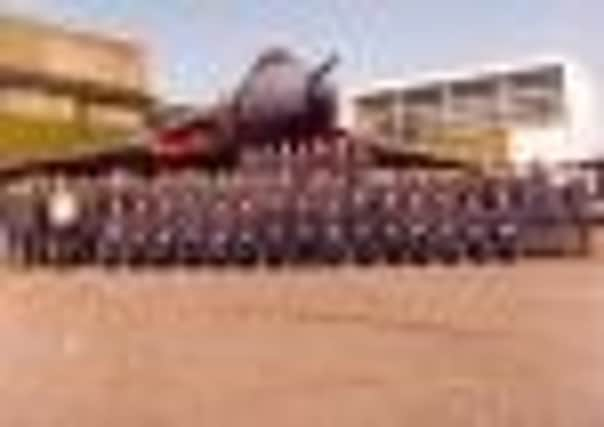Keeping the last Vulcan flying. . .


They were the distinctive triangular-winged bombers that flew overhead so regularly we barely even acknowledged them as we played out on camp. My dad worked on vulcans at RAF Waddington near Lincoln, where a stationary one still stands as the ‘gate guardian’, and I have a photo of him and his squadron grouped neatly in front of one.
Vulcans are one of the few planes I can recognise and name instantly, along with the AWACS which followed them at Waddington, with their equally distinctive spaceship-like extensions.
Advertisement
Hide AdAdvertisement
Hide AdVulcans were also the planes that played such a significant part in the Falklands war in 1982, when we schoolchildren would hear them taking off with their distinctive ghostly howl on their 15-hour journey to the South Atlantic.


So there was some poignancy to my visit to see the last flying Vulcan, number XH558, Spirit of Great Britain, which is being looked after so lovingly by the Vulcan to the Sky charity.
Walking into the hangar and seeing this old lady of the skies up close was like rolling back the years to when I would accompany my dad to his workplace occasionally. That distinctive smell of oil and grease, everything coloured military khaki or grey, all bringing back memories.
The camaraderie between the ex-RAF crew members and the obvious affection they have for the plane, which they refer to as ‘she’, was also familiar to me and something distinctive to the Forces, where everyone has a nickname, often based on where you come from.
Advertisement
Hide AdAdvertisement
Hide AdThey are led by crew chief Taff (guess where he’s from) Stone who back in the early 80s was part of the team going round the country scrapping the Vulcans when they were hastily recommissioned to take part in the Falklands war.


“Then I found myself back at Waddington getting them back into service,” he laughed.
The pilot of the first Vulcan engaged in a bombing raid on Port Stanley was Sqd Ldr Martin Withers, known as Black Buck 1, who almost didn’t have enough fuel to get back to Ascension Island and earned a Distinguished Flying Cross for his bravery. He is now the chief pilot of Vulcan 558, taking it to air shows and displays around the UK.
The Falklands war was at that time the longest bombing raid in history.
Advertisement
Hide AdAdvertisement
Hide AdSitting in the dark and claustrophobic cockpit, which normally carried a crew of five but could seat seven at a squeeze, I was struck by how uncomfortable that 15-hour flight must have been.


The pilot and co-pilot sat ‘upstairs’ while the navigation crew sat down below facing backwards, monitoring the radar.
In the event of a catastrophe, there were ejector seats for the pilots but the rest of the crew had to rely on bailing out of the open doors with their parachutes.
Taff, who served in the RAF for 26 years, leads a crew of five engineers working on Vulcan 558, who is 51 years old this month.
She is an expensive old lady to keep as well.


Advertisement
Hide AdAdvertisement
Hide AdIt takes £2m a year to keep her flying, money which all has to be raised through charitable donations.
Vulcan to the Sky business development director Michael Trotter said: “When the charity bought her from the Walton family in the early 2000s we were told she would take £2.7m to restore but she ended up costing £7m.”
“It costs us £4,500 an hour in fuel every time she flies.”
Lining the bomb doors are the names of patrons of the charity which is hoping to keep the Vulcan flying until at least 2013, when engine and wing fatigue will probably lead to her being grounded.
Having her based at a civilian airport makes it easier for the charity to bring in guided tours and hold special events in the hangar, which will make raising funds a bit easier.
Advertisement
Hide AdAdvertisement
Hide AdMichael said: “If everyone could sign up to donating £5.58 a month, in honour of her number, that would be brilliant.”


He explained how Vulcans were also crucial in the Cold War when the threat of a nuclear attack hung over the country, and particularly during the Cuban Missile Crisis in 1962 when crews were ready and waiting in the cockpit around the clock, ready to put to flight at a moment’s notice.
“They were ready to scramble and be in the air in under four minutes if necessary by pressing a button which started all four engines at once,” he said.
“Those pilots knew that if the call came it meant nuclear bombers were on there way here from Russia, so they knew it was a one-way ticket and there would be nothing to come home to afterwards.”
To donate or to find out about visiting the Vulcan and where she will be flying go to www.vulcantothesky.org.
l To watch a video tour of Vulcan XH558 go to www.worksop-guardian.co.uk.